Aliexpress brain
Only AliExpress could take the Bachelor's Day, a student holiday with a touch of sadness, and transform it in a few years into International Shopping Day. For several years now 11.11 has been easily and naturally competing with Black Friday, capturing the whole world. Of course, the retail leader of such strength and such potential could not ignore modern technologies. Recently, AliExpress is not just carried away by fashionable gadgets and applications, but also began to earn a lot from them. Lots of. Recently, our company Fibrum has created a platform that served as the basis for the virtual store AliExpress. In this article I will talk about the features of this platform of VR stores. By the way, for our platform points are not nnnada. Almost.
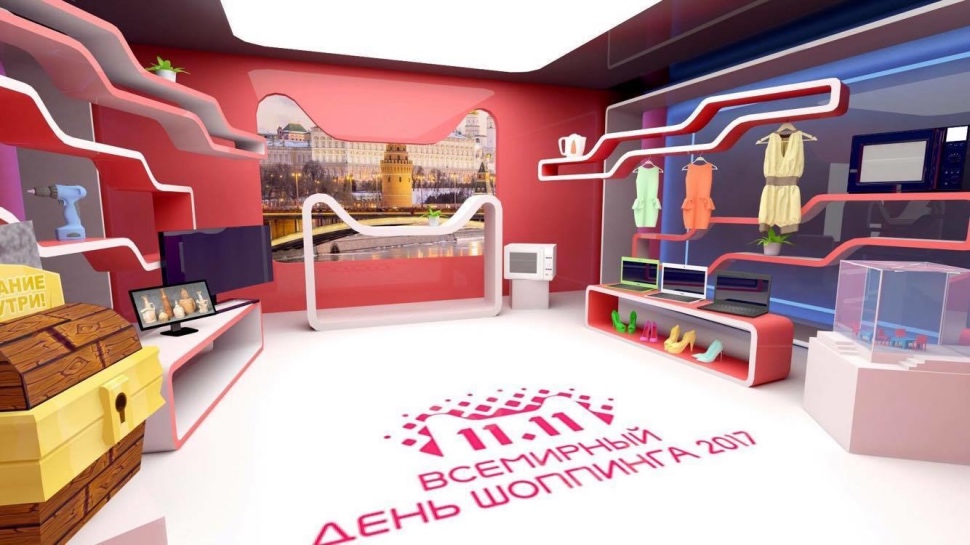
Many people know that on November 11, the Chinese, fascinated by the magic of numbers, celebrate the Day of the Bachelor, as this date brings together four units (11.11). In recent years, more and more sales in online stores are taking place on Bachelor's Day, and on November 11th, it becomes the Chinese “Black Friday”. Therefore, our joint project with AliExpress was dedicated to the day of online shopping in the Middle Kingdom.
AliExpress itself has already tested VR stores in 2016. The commercial success of this experiment last year's Black Friday was phenomenal - 8 million people visited VR shops. Not surprisingly, AliExpress decided to continue in the same spirit, only now in Russia.
')
This is how AliExpress's VR stores look for users from Australia, America and Japan.
The first Alibaba project was slightly different from the Russian in that it was implemented using augmented technology, not virtual reality. About the project you can see a CNN report.
On November 3, 2017, we carried out a trial launch of the AliExpress virtual store in our country. And on November 7, the Tmall store in virtual reality earned its full potential: in 11 Russian cities, an advertisement with QR codes was placed, by which it was possible to go to the store with VR goods from AliExpress.
In 2015, our company won the joint start-up competition Skolkovo and AliExpress, and we received the right to place Fibrum Pro VR helmets on the Chinese market. So began our collaboration with AliExpress. It was successful, and it was decisive when choosing a contractor to create virtual stores in Russia.
By the way, in 2016, a personal meeting of Alibaba founder Jack Ma with Fibrum CEO Ilya Flax was held during the World Internet Forum in China. We donated our VR helmet to Jack Ma. Although the conversation was not very long, during this time, Ilya and Jack managed to talk about our products.
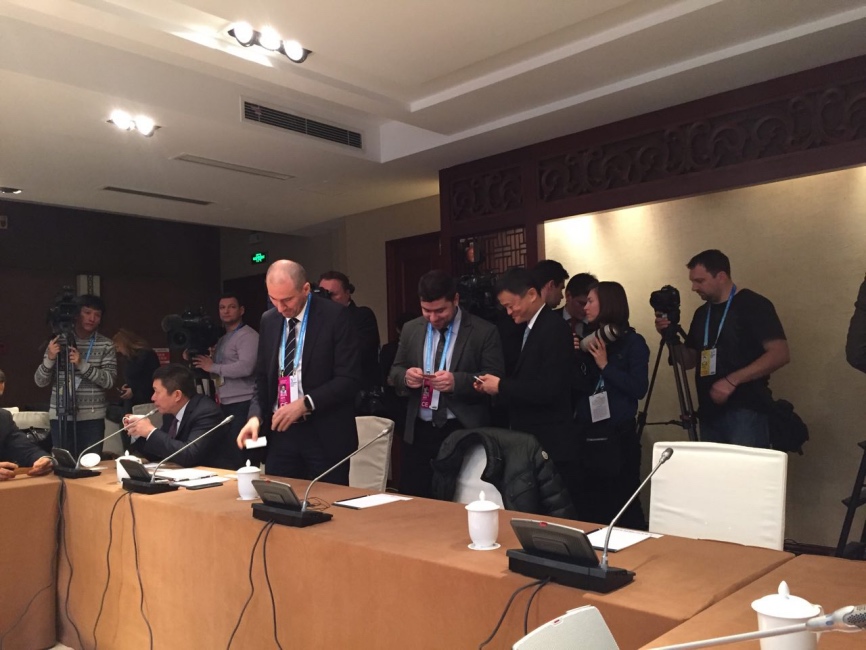
According to the scan of the QR code or via a direct link, the buyer enters the store, selects one of three departments (virtual rooms “Technique”, “Children” and “Fashion”) and turns out to be among the virtual products.
The user moves through the virtual store, directing his gaze in the right direction and activating the button with the feet icon.
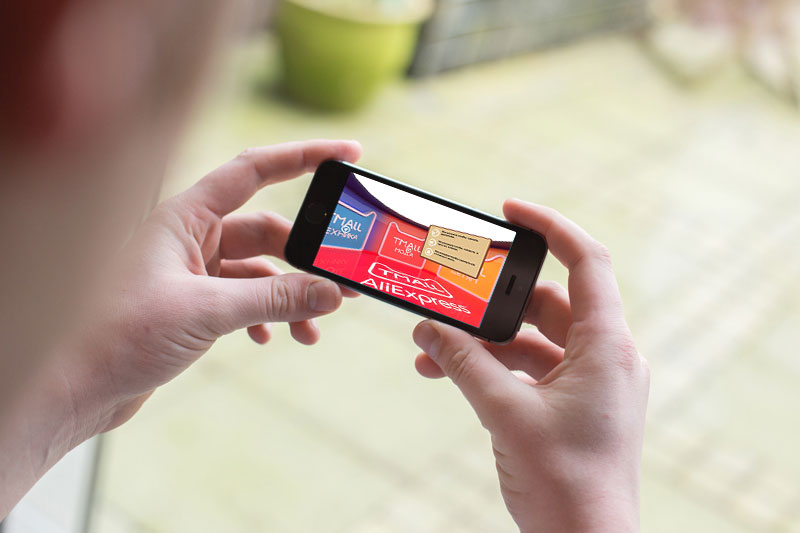
To select a product, the user detains a glance on it, which causes loading of the retaykl (pointer in the center of the sight), after which a scene opens with a close-up - a detailed view of the product and its characteristics with the ability to rotate it along the X axis, as well as add to the basket.
In fact, the user does not need a virtual reality helmet (access is possible from a regular browser), but for a more complete immersion in VR, I would advise you to put on a helmet - this is more interesting. The main thing is that the helmet is compatible with your phone.
To captivate the buyer, we used the mechanics of the game and came up with various "chips".
For each action (even for entrances and exits from rooms), gamification points are awarded to the user.
If you catch a cat that “walks” in Tmall, you can “earn” a coupon for $ 2-4. Rush through the rooms for the animals do not have to. In our store there is no soundtrack, and only the cat gives out its presence with the next “meow. When the user hears the "cat", he must "catch" his gaze to get a discount.
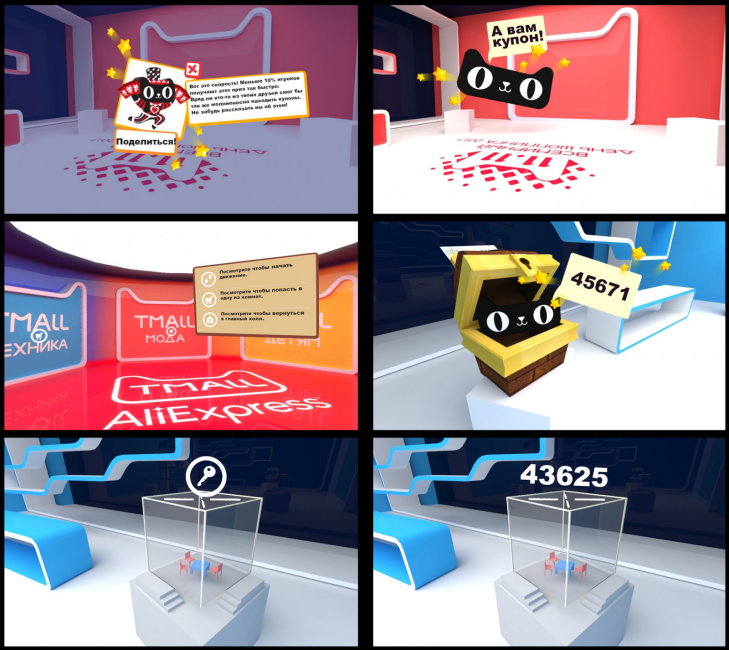
For pointing the smartphone to the glass cube, which is in each room, the user received an invitation to the offline event Tmall, which was held in Moscow at the shopping center "Atrium". Gaining points, the user acquires a special status, which can be shared on social networks.
They also put Tinkoff Chest in the rooms: by opening it, the buyer can get a bonus on the purchase of goods.
Colleagues from AliExpress insisted that we do everything in the browser, since it is much more convenient than the traditional model with the creation of a separate application, which can only be used with a virtual reality helmet. Web-VR is more accessible, and this has become a decisive factor. Then it seemed almost impossible. Moreover, in the month we were given everything for everything.
We took the risk, although we understood that no one had made such decisions and there would be many problems along the way.
Following the results of consultations with AliExpress experts, we wrote a technical task, within which we began development. From AliExpress, we received photos of the goods and, on their basis, made 3D models. In general, the 3D modeling process was fairly standard, except for the need to convert the resulting files into a special format that is used in the framework. For example, this is how a room model looks like with objects in it.
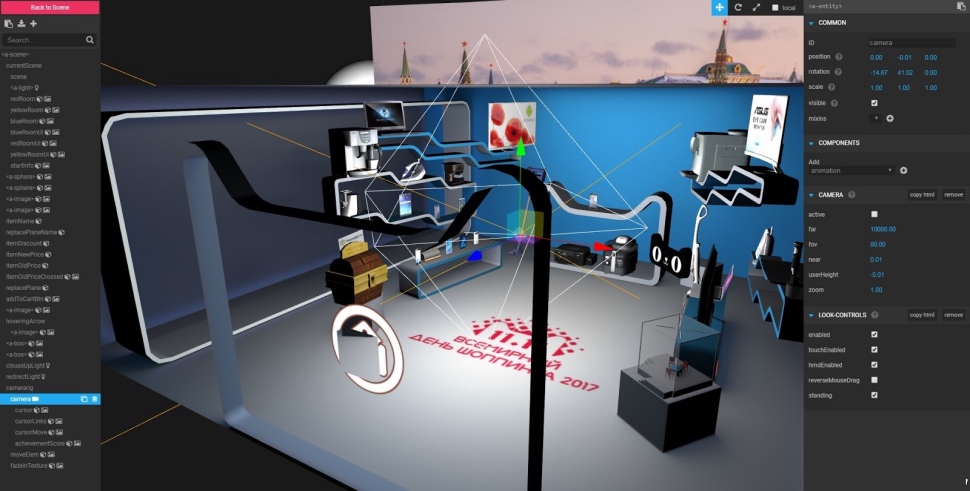
On the client side, the design of the hall and rooms, pop-up windows with game achievements and some other graphic elements was also created. The technical implementation of the project was completely on our side.
Eight specialists worked on the platform: three designers, two developers, a tester, a product manager, and an art director. The product manager oversaw the interaction with AliExpress. The art director was responsible for the visual component.
As a result, our team got a very complex technological solution with several rooms, gamification, with VR mode in the browser from any phone.
The AliExpress platform for the VR store is designed from scratch using the A-Frame HTML framework for creating virtual reality websites (also known as Web-VR). The main rendering technology is WebGL.
Since the virtual reality in the project for AliExpress is implemented as a web application running in a browser, the resources for it are allocated differently. And since there is no need to create heavy graphic elements, its performance is higher than that of classic VR solutions.
To track a person’s movements, our AliExpress solution only uses internal phone sensors: an accelerometer and a gyroscope. We also took into account the existence of phones without a gyroscope and bypassed this limitation by implementing the control of the movements of the fingers on the screen. This project does not imply a system for tracking the position of a person in space.
I have heard more than once complaints from users who have tried VR, on delays when turning their head and a fuzzy image. All this is not relevant to AliExpress, since it was developed on the basis of Web-VR and is not an application that is installed directly from the store. The insufficient distance between the objects (also a frequent complaint of VR users) in this project is again not a big problem: we identified something like this at the testing stage, slightly rearranged the objects on the shelves, and it became comfortable.
The project’s weak points and our main “rake” are incomplete support for modern smartphones by Web-VR browsers. Web-VR is still actively developing, being finalized, and some features can be implemented using polyfiles . Accordingly, one hundred percent functionality of the functional cannot be guaranteed and must be thoroughly tested.
In AliExpress they say that if our solution succeeds, they will consider the possibility of launching full-fledged virtual stores in other countries, since opening and maintaining stores of the new format is much cheaper than regular points of sale, and you can place them without reference to shopping centers or stores.
Fibrum also gained a very valuable experience in developing Web-VR projects, which could later be scaled to other projects. We hope that the example of AliExpress will inspire Russian companies to more actively use virtual reality as a sales channel.
In the meantime, we are working on another project - the launch of a new application in which you can choose an emotion and try it out, going on adventures in virtual reality. Of course, we will also tell Habr readers about him. But next time.

First experiments with a different reality
Many people know that on November 11, the Chinese, fascinated by the magic of numbers, celebrate the Day of the Bachelor, as this date brings together four units (11.11). In recent years, more and more sales in online stores are taking place on Bachelor's Day, and on November 11th, it becomes the Chinese “Black Friday”. Therefore, our joint project with AliExpress was dedicated to the day of online shopping in the Middle Kingdom.
AliExpress itself has already tested VR stores in 2016. The commercial success of this experiment last year's Black Friday was phenomenal - 8 million people visited VR shops. Not surprisingly, AliExpress decided to continue in the same spirit, only now in Russia.
')
This is how AliExpress's VR stores look for users from Australia, America and Japan.
The first Alibaba project was slightly different from the Russian in that it was implemented using augmented technology, not virtual reality. About the project you can see a CNN report.
On November 3, 2017, we carried out a trial launch of the AliExpress virtual store in our country. And on November 7, the Tmall store in virtual reality earned its full potential: in 11 Russian cities, an advertisement with QR codes was placed, by which it was possible to go to the store with VR goods from AliExpress.
Why AliExpress chose Fibrum
In 2015, our company won the joint start-up competition Skolkovo and AliExpress, and we received the right to place Fibrum Pro VR helmets on the Chinese market. So began our collaboration with AliExpress. It was successful, and it was decisive when choosing a contractor to create virtual stores in Russia.
By the way, in 2016, a personal meeting of Alibaba founder Jack Ma with Fibrum CEO Ilya Flax was held during the World Internet Forum in China. We donated our VR helmet to Jack Ma. Although the conversation was not very long, during this time, Ilya and Jack managed to talk about our products.

What does a VR shop look like?
According to the scan of the QR code or via a direct link, the buyer enters the store, selects one of three departments (virtual rooms “Technique”, “Children” and “Fashion”) and turns out to be among the virtual products.
The user moves through the virtual store, directing his gaze in the right direction and activating the button with the feet icon.

To select a product, the user detains a glance on it, which causes loading of the retaykl (pointer in the center of the sight), after which a scene opens with a close-up - a detailed view of the product and its characteristics with the ability to rotate it along the X axis, as well as add to the basket.
In fact, the user does not need a virtual reality helmet (access is possible from a regular browser), but for a more complete immersion in VR, I would advise you to put on a helmet - this is more interesting. The main thing is that the helmet is compatible with your phone.
Buyers - gamers
To captivate the buyer, we used the mechanics of the game and came up with various "chips".
For each action (even for entrances and exits from rooms), gamification points are awarded to the user.
If you catch a cat that “walks” in Tmall, you can “earn” a coupon for $ 2-4. Rush through the rooms for the animals do not have to. In our store there is no soundtrack, and only the cat gives out its presence with the next “meow. When the user hears the "cat", he must "catch" his gaze to get a discount.

For pointing the smartphone to the glass cube, which is in each room, the user received an invitation to the offline event Tmall, which was held in Moscow at the shopping center "Atrium". Gaining points, the user acquires a special status, which can be shared on social networks.
They also put Tinkoff Chest in the rooms: by opening it, the buyer can get a bonus on the purchase of goods.
Technical implementation
Colleagues from AliExpress insisted that we do everything in the browser, since it is much more convenient than the traditional model with the creation of a separate application, which can only be used with a virtual reality helmet. Web-VR is more accessible, and this has become a decisive factor. Then it seemed almost impossible. Moreover, in the month we were given everything for everything.
We took the risk, although we understood that no one had made such decisions and there would be many problems along the way.
Following the results of consultations with AliExpress experts, we wrote a technical task, within which we began development. From AliExpress, we received photos of the goods and, on their basis, made 3D models. In general, the 3D modeling process was fairly standard, except for the need to convert the resulting files into a special format that is used in the framework. For example, this is how a room model looks like with objects in it.

On the client side, the design of the hall and rooms, pop-up windows with game achievements and some other graphic elements was also created. The technical implementation of the project was completely on our side.
Eight specialists worked on the platform: three designers, two developers, a tester, a product manager, and an art director. The product manager oversaw the interaction with AliExpress. The art director was responsible for the visual component.
As a result, our team got a very complex technological solution with several rooms, gamification, with VR mode in the browser from any phone.
The AliExpress platform for the VR store is designed from scratch using the A-Frame HTML framework for creating virtual reality websites (also known as Web-VR). The main rendering technology is WebGL.
Since the virtual reality in the project for AliExpress is implemented as a web application running in a browser, the resources for it are allocated differently. And since there is no need to create heavy graphic elements, its performance is higher than that of classic VR solutions.
To track a person’s movements, our AliExpress solution only uses internal phone sensors: an accelerometer and a gyroscope. We also took into account the existence of phones without a gyroscope and bypassed this limitation by implementing the control of the movements of the fingers on the screen. This project does not imply a system for tracking the position of a person in space.
I have heard more than once complaints from users who have tried VR, on delays when turning their head and a fuzzy image. All this is not relevant to AliExpress, since it was developed on the basis of Web-VR and is not an application that is installed directly from the store. The insufficient distance between the objects (also a frequent complaint of VR users) in this project is again not a big problem: we identified something like this at the testing stage, slightly rearranged the objects on the shelves, and it became comfortable.
The project’s weak points and our main “rake” are incomplete support for modern smartphones by Web-VR browsers. Web-VR is still actively developing, being finalized, and some features can be implemented using polyfiles . Accordingly, one hundred percent functionality of the functional cannot be guaranteed and must be thoroughly tested.
Results and prospects
In AliExpress they say that if our solution succeeds, they will consider the possibility of launching full-fledged virtual stores in other countries, since opening and maintaining stores of the new format is much cheaper than regular points of sale, and you can place them without reference to shopping centers or stores.
Fibrum also gained a very valuable experience in developing Web-VR projects, which could later be scaled to other projects. We hope that the example of AliExpress will inspire Russian companies to more actively use virtual reality as a sales channel.
In the meantime, we are working on another project - the launch of a new application in which you can choose an emotion and try it out, going on adventures in virtual reality. Of course, we will also tell Habr readers about him. But next time.
Source: https://habr.com/ru/post/344944/
All Articles